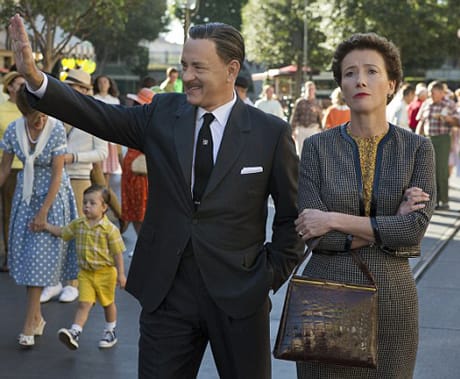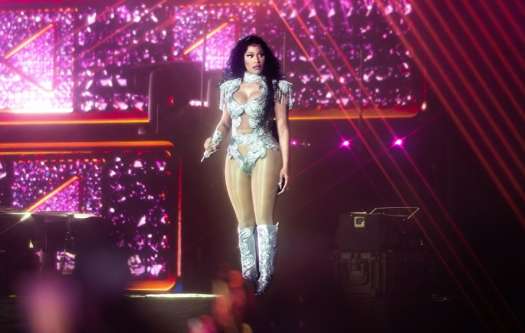No one is as aware of Disney's history in Western Culture as the studio itself. That's why you see the company backing films like Who Framed Roger Rabbit and Enchanted, which play with our collective understanding of the Disney brand and its characters while simultaneously reinforcing their canonical status in our culture.
Saving Mr. Banks, which tells the story of how Disney came to make live-action family classic Mary Poppins, goes a step further. It portrays the studio, its theme park and Walt Disney himself as a bunch of aw-shucks slices of Americana, bound to be misunderstood by the stuffiness of the old world, as represented by Mary Poppins creator P.L. Travers. This, apparently, is the way Disney views its contribution to America, and they want us to fall in line.
Interweaving narratives tell the story, delivering two tales, neither of which is integral to the understanding of the other. The first concerns a young Travers living in Australia, the favourite child of her alcoholic father (Colin Farrell, who despite his dodgy rep as a leading man, once again proves his worth in a supporting role), who's unbound and inebriated imagination endears him to his children, even if it makes him a pariah in the community and with his wife.
The other builds on Disney's already formidable legend. In this later narrative, Travers is a full-grown woman and already a successful author, having penned a series of books about the fictional character Mary Poppins. Walt Disney wants to make a movie out of her beloved Mary and, faced with mounting bills, she reluctantly agrees to fly to California to oversee the creation of a script; she has final approval and won't sign over the rights to the character until she's satisfied. Her increasingly unreasonable and flighty demands, however, ensure this will never happen, thereby allowing Travers to walk away from the lucrative deal while blaming the debacle on the studio.
Travers is a likeable curmudgeon here — credit Emma Thompson for that — who seems to relish putting Don DaGradi (Bradley Whitford) and Richard and Robert Sherman (Jason Schwartzman and B.J. Novak) through their paces. But it's the scene between Travers and Walt Disney himself (a construction of Disney's most likeable traits — no ugly character flaws here — played by the always likeable Tom Hanks) that are the most fun to watch, even if we know these exchanges have been glamourized for our enjoyment.
The two tales are so tonally different they could be completely different films, especially Travers' childhood in Australia, which plays more like Finding Neverland than anything Disney's ever produced. While it's obvious from the outset that the roots of the Poppins character lay here (George Banks is based on her father, Mary based on her wealthy and practical Aunt), these storylines nevertheless feel incongruous and the cuts back and forth between the two are jarring.
Yet for all of Saving Mr. Banks' flaws, and there are many, the overall effect is surprisingly pleasant — chalk it up to its remarkably likeable cast portraying characters excised of any real flaws. There is no doubt that a campaign is already underway to get Thompson and Hanks nominated for Oscars, while the studio can rest easy knowing it has one of the few watchable family films on offer this holiday season.
Saving Mr. Banks' thesis, that sometimes it's more satisfying to let go and accept the fantasy, is laid out by Hanks's Disney as he desperately tries to convince Travers to allow him to make his version of Mary Poppins. So while we might not have to accept Saving Mr. Banks as a slice of history, we can at least embrace the version it puts forward as an enjoyable slice of imagination from the studio that set the bar for such things.
(Disney)Saving Mr. Banks, which tells the story of how Disney came to make live-action family classic Mary Poppins, goes a step further. It portrays the studio, its theme park and Walt Disney himself as a bunch of aw-shucks slices of Americana, bound to be misunderstood by the stuffiness of the old world, as represented by Mary Poppins creator P.L. Travers. This, apparently, is the way Disney views its contribution to America, and they want us to fall in line.
Interweaving narratives tell the story, delivering two tales, neither of which is integral to the understanding of the other. The first concerns a young Travers living in Australia, the favourite child of her alcoholic father (Colin Farrell, who despite his dodgy rep as a leading man, once again proves his worth in a supporting role), who's unbound and inebriated imagination endears him to his children, even if it makes him a pariah in the community and with his wife.
The other builds on Disney's already formidable legend. In this later narrative, Travers is a full-grown woman and already a successful author, having penned a series of books about the fictional character Mary Poppins. Walt Disney wants to make a movie out of her beloved Mary and, faced with mounting bills, she reluctantly agrees to fly to California to oversee the creation of a script; she has final approval and won't sign over the rights to the character until she's satisfied. Her increasingly unreasonable and flighty demands, however, ensure this will never happen, thereby allowing Travers to walk away from the lucrative deal while blaming the debacle on the studio.
Travers is a likeable curmudgeon here — credit Emma Thompson for that — who seems to relish putting Don DaGradi (Bradley Whitford) and Richard and Robert Sherman (Jason Schwartzman and B.J. Novak) through their paces. But it's the scene between Travers and Walt Disney himself (a construction of Disney's most likeable traits — no ugly character flaws here — played by the always likeable Tom Hanks) that are the most fun to watch, even if we know these exchanges have been glamourized for our enjoyment.
The two tales are so tonally different they could be completely different films, especially Travers' childhood in Australia, which plays more like Finding Neverland than anything Disney's ever produced. While it's obvious from the outset that the roots of the Poppins character lay here (George Banks is based on her father, Mary based on her wealthy and practical Aunt), these storylines nevertheless feel incongruous and the cuts back and forth between the two are jarring.
Yet for all of Saving Mr. Banks' flaws, and there are many, the overall effect is surprisingly pleasant — chalk it up to its remarkably likeable cast portraying characters excised of any real flaws. There is no doubt that a campaign is already underway to get Thompson and Hanks nominated for Oscars, while the studio can rest easy knowing it has one of the few watchable family films on offer this holiday season.
Saving Mr. Banks' thesis, that sometimes it's more satisfying to let go and accept the fantasy, is laid out by Hanks's Disney as he desperately tries to convince Travers to allow him to make his version of Mary Poppins. So while we might not have to accept Saving Mr. Banks as a slice of history, we can at least embrace the version it puts forward as an enjoyable slice of imagination from the studio that set the bar for such things.




